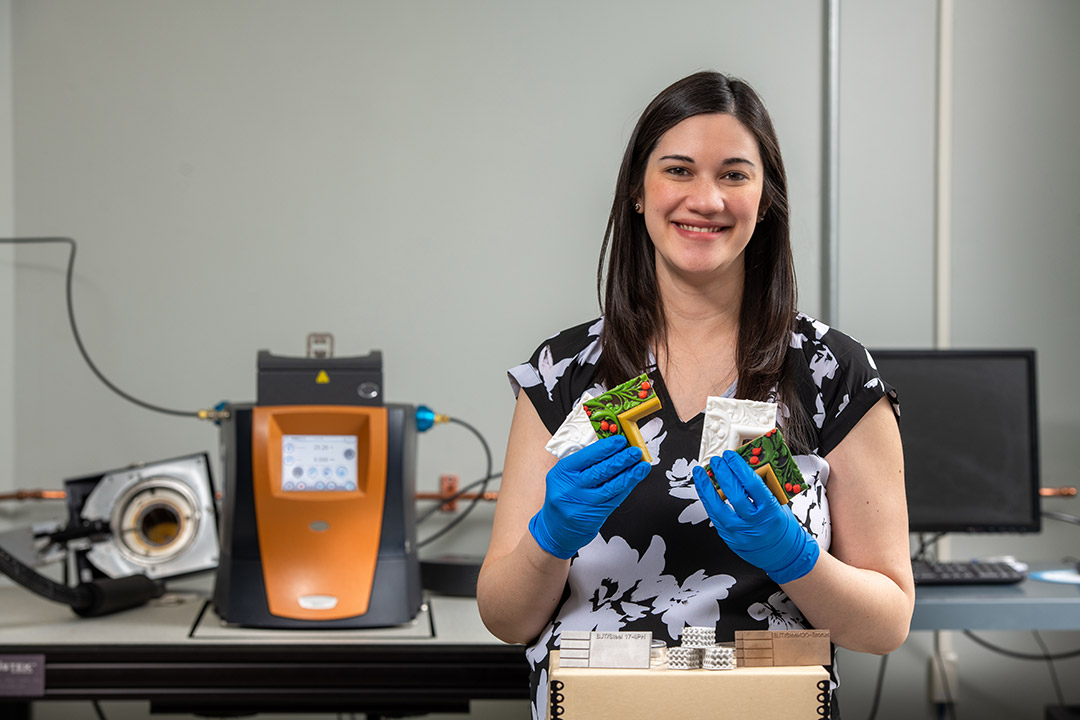New grant supports Image Permanence Institute’s research on the stability of 3D-printed objects
The National Endowment for the Humanities awarded IPI $315,854 to support two years of research
Carlos Ortiz
Meredith Noyes, research scientist at the Image Permanence Institute, shows some of the 3D-printed samples she’ll be conducting tests on during her research.
Museums, libraries, and other cultural institutions have embraced 3D printing as a tool for display, storage, preservation and conservation, and more. However, there is not much known about the safety and longevity of 3D-printed materials in these contexts, despite their widespread use within cultural heritage.
To help address this void in research, Meredith Noyes, research scientist at RIT’s Image Permanence Institute (IPI), received a grant from the National Endowment for the Humanities for a research project titled “Evaluating the Mechanical Stability of 3D Printed Materials to Inform Collections Care Decision Making.”
Noyes, principal investigator for the grant, explained that, surprisingly, the lack of research regarding 3D-printing materials hasn’t held cultural heritage professionals back from using the technology. Cultural heritage professionals are often conservative when choosing what types of materials are used with historic objects, and while some have shown hesitance to the technology, many have embraced 3D printing simply because it is new and innovative.
“3D-printed objects have a very different physical structure than their traditionally made counterparts, and the type of additive manufacturing process that someone chooses to use can have a significant impact on the mechanical stability of these objects or materials,” said Noyes. “In this project, we will be investigating the mechanical stability and environmental response of 3D-printing materials that are currently being used by museum professionals in three different contexts: physical supports for objects on display or in storage, conservation fills and integrations, and replacement parts on working museum objects that receive visitor interaction.”
Noyes is working with Emma J. Richardson, director of research at IPI, and Marvin Cummings, research scientist at IPI, to complete the project. The end goal for the team is to create a “decision-making tree” to help guide professionals in determining the best uses for different types of 3D-printing materials in collections care and display, or when it may be best to let traditional tools take care of the job.
Through their previous research, scientists at IPI have found that digital scanning and printing technologies are increasingly used by cultural institutions as they offer new opportunities to reduce the risk of damage to objects during treatment and exhibition preparation by enabling custom-tailored solutions in minimally invasive ways. While 3D printing offers improved efficiencies and outcomes for certain applications, the mechanical and chemical stability of printed materials used in these contexts remains understudied.
“Our goal is to help people make more informed decisions about when to use this technology. It’s interesting to see that people are applying it in a number of different ways, but it’s possible that certain 3D-printing materials and technologies are not optimum for a lot of applications,” said Richardson. “We are aiming to identify best practice when using 3D-printing in particular contexts, and highlight when we might guide people away from using 3D-printing. Our work requires a pragmatic approach to reducing risk and ensuring access to collections.”
As Noyes and the team begin their research, they’re partnering with RIT’s AMPrint Center for Additive Manufacturing and Multifunctional Printing to create 3D-printed samples that they can test to observe how they respond to a variety of changing environments in a lab setting. As the research progresses, IPI will lean into its partnership with The Strong National Museum of Play and the Cleveland Museum of Art to conduct studies with real collection objects and exhibit environments.
Go to the Image Permanence Institute website to learn more about its ongoing research projects and for future updates on this grant project.



